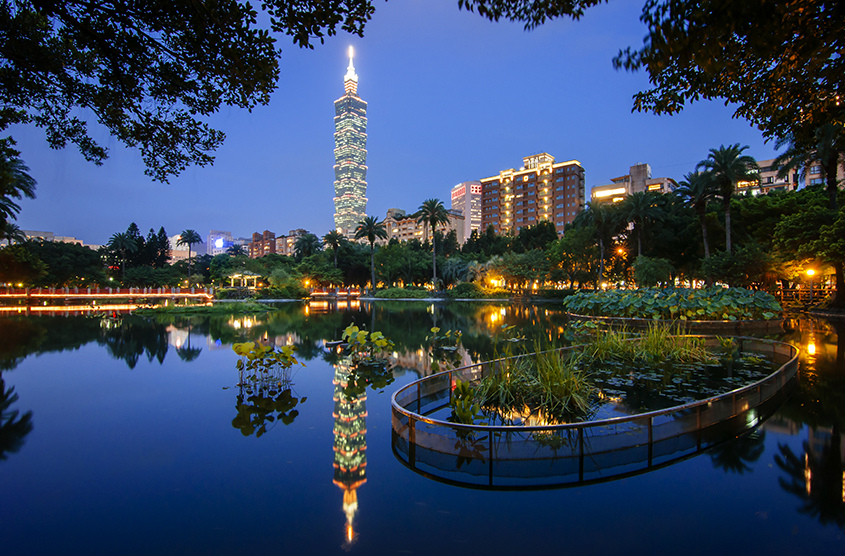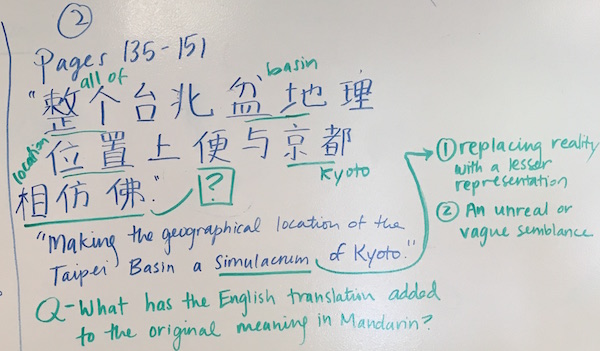
Pages 135-151
A reading route prepared by Serena (FLAC), Xiaoping, Mengxi, Katy
There are 2 parallel mirror images to observe in the context of this novel; the cities Taipei and Tokyo, and the former friends You and A. Although these mirror images have similar appearances (the Japanese built Taipei as a mirror image of Kyoto), they are intrinsically different. You and Kyoto are resistant to change whereas A and Taipei are willing to change over time. You seems to think that Kyoto is stable and unchanging, while she is disgusted with the changes in her home city. The Japanese colonization of Taipei was unable to make the two cities the same on the inside, as Taipei has been changed by each of its different governors. Analogous to these cities, You strives to stay the same–like the unchanging city of Kyoto–whereas A continually changes–just like Taipei–into an American.
Image: Taipei 101 Reflections, Sun Yat-sen Memorial Hall. Flickr
“No need to go ashore, no need to shave your head, no need to change your clothing style; sending tribute and being a royal subject will suffice” (E135).
“不必登岸,不必薙发,不必易衣冠,称臣入贡可也” (S149)
[/et_pb_vertical_timeline_item][et_pb_vertical_timeline_item title=”Stop 2″ use_read_more=”off” animation=”off” text_font_select=”default” text_font=”||||” headings_font_select=”default” headings_font=”||||” use_border_color=”off” border_style=”solid”]
“You worried that A, given the shortness of her visit, would not be able to see the cherry blossoms –oh god, you might see her when you got back to the hotel that night. You hoped she wouldn’t lard her speech with English, like so many people who had been out of the country far too long, because that would only increase the tension in your exchanges. You also hoped she wouldn’t be dressed sloppily and attract attention, like most Americans. Of course you couldn’t imagine A in stuffy clothes like a suit or jacket and silk scarf.” (E162-163)
“你不禁担心A短短的假期会等不到樱花正笑——天啊你晚上回旅馆可能就会看到A你但愿她不会像很多去国多年的人一样满口英文,那样会增加你们沟通的紧张度,你也希望A不要像美国人那样不修边幅引人注目,当然你不能想象A穿得规规矩矩例如西装式外套系丝巾什么的” (S169)
[/et_pb_vertical_timeline_item][et_pb_vertical_timeline_item title=”Stop 3″ use_read_more=”off” animation=”off” text_font_select=”default” text_font=”||||” headings_font_select=”default” headings_font=”||||” use_border_color=”off” border_style=”solid”]
“Japan tore down the city wall ten years after the Qing built it. The Japanese were no different from the Manchu Qing court: if it wasn’t “perhaps we should level the place,” it was “sell Taiwan for a billion dollars.” They dissembled the bricks and tiles laboriously fired in Beishihu and built three-lane streets, along which were planted nightshade trees, which were popular all over the island, and betel palms and coconut trees to give them a southern flavor, 150 of them on Aiguo (East)[West] Road and 100 on Xinyi Road.” (E147)
其后十年,日人拆城。日人跟清人一样,不是“延议欲墟其地”就是“一亿元台湾卖却论”。他们拆了北势湖辛苦烧成的瓦砖,辟成三线道路,植上一五〇株(爱国西路)一〇〇株(信义路)南岛遍见的茄冬和代表南国风情的槟榔椰子树。” (S158)
[/et_pb_vertical_timeline_item][et_pb_vertical_timeline_item title=”Stop 4″ use_read_more=”off” animation=”off” text_font_select=”default” text_font=”||||” headings_font_select=”default” headings_font=”||||” use_border_color=”off” border_style=”solid”]
“If not for the fire caused by a Japanese fighter plane shot down toward the end of the war, the ruined Taiwan Shrine would have been a lot of like the Yasaka Shrine, which you visited often. In Governor-General Nogi’s time, the Imperial Council decided, on advisement, to build the shrine in Taipei, Taiwan’s control center. Tainan and Keelung had both been considered. The reason for the final decision was: if the ancient city of Taipei was to be considered the site of the imperial residence, then the Keelung River would be the equivalent of the Kamo-gawa and Jiantan Hill would be Higashi-yama, making the geographical location of the Taipei Basin a simulacrum of Kyoto.” (E203)
“台湾神社,若非毁于战争末期日军飞行机坠落所引发的大火,应该同于你常参拜的八坂社吧。乃木总督时代,帝国议会接受建议把神社设于统治中心台北,前此台南,基隆都曾经是考虑地点,最终决定的原因是若把台北古城当作皇居御所,那基隆河便是鸭川剑潭山是东山,整个台北盆地在地理位置上便与京都相仿佛.” (S196)
[/et_pb_vertical_timeline_item][et_pb_vertical_timeline_item title=”Stop 5″ use_read_more=”off” animation=”off” text_font_select=”default” text_font=”||||” headings_font_select=”default” headings_font=”||||” use_border_color=”off” border_style=”solid”]
“The only difficult decision was where to take your afternoon tea–Fauchon, in the basement level of Takashi-maya, or Rakusho, by the entrance to Kokaiji Temple. The afternoon tea at Fauchon–a scone and a cup of house blend coffee or black tea–cost 500 yen, a price that had remained the same for years, whether the value of the yen appreciated dramatically or dropped precipitously. You deeply missed the seats, so few that there was usually a long line. You’d often see neatly dressed old couples, in their seventies at least, taking their meals solemnly, as if conducting a ritual of sorts. They talked in whispers and did not look or act like the average Japanese. You were pretty sure they were probably Deng Xiaoping’s classmates when he studied in France.” (E135)
“唯令人难以决定的是,你的下午茶要到高岛屋地下一楼的fauchon,还是高台寺参道口旁的洛匠。Fauchone的午茶,一块英式松饼和一盅当店的热咖啡或红茶,五百円,其间无论日元暴走或暴跌,数年不变,你非常想念那没几个座位因此常得排长龙的咖啡座,常有穿戴讲究少说七十岁以上的老夫妻在那儿进行某种仪式般地庄严用餐,低声交谈,表情举止不像一般日本老人,你几乎肯定他们大约是青年邓小平的留法同学们” (S150)
[/et_pb_vertical_timeline_item][et_pb_vertical_timeline_item title=”Stop 6″ use_read_more=”off” animation=”off” text_font_select=”default” text_font=”||||” headings_font_select=”default” headings_font=”||||” use_border_color=”off” border_style=”solid”]
“Occasionally, when one of A’s male friends had some money from a tutoring job or had been paid by a magazine for photos, he invited the two of you to Banyan Gardens, where you ordered a bottle of beer and a plate of stir-fried little shellfish, and talked about the national shame of the nearby Dutch garrison, called the Red Hair building, until you choked on your own words. The price of coffee in Banyan Gardens had spiked. After silently calculating the exchange rate, you realized it was more expensive than in any other country (except for the Blue Mountain coffee in the Imperial Hotel, designed by Frank Lloyd Wright), but you needed to sit a while to put your colonial map in order.” (E 205-206)
“也偶有A的男生朋友拿到家教费或摄影作品被杂志采用,就请你们去榕园喊瓶啤酒炒盘仔,讲不远处的红毛城国耻直到哽咽难言。现在的榕园咖啡好贵,你在心底汇兑了一番,贵过你在其他国家所喝过的(只除了莱特盖的帝国饭店的蓝山),不过你需要坐一会儿以便整理你的殖民地地图。” (S198)
[/et_pb_vertical_timeline_item] [/et_pb_vertical_timeline]
Note 1
Our theme quote is excerpted from a Qing Dynasty letter to the ruler of Taiwan at the time, Zheng Jing. These words demonstrate the Qing dynasty’s wish to control Taiwan, though the letter claims that Qing rulers will not force the residents of Taiwan to change. Even though Zheng Jing was less powerful by that time, more like a “shadow” in a mirror, he resists to be a shadow that changes with the Qing government. This quote plays a part in drawing the readers’ attention toward change. Observing the physical and emotional changes of the characters throughout the novel emphasizes the main character’s negative perception of change. Her strong emotional response to change allows us to observe how she feels like an outsider whenever places or friends change, and how she feels at home where things remain constant. Because of her contrasting experiences in the “twin” cities of Taipei and Tokyo, and the contrasts between You and A, we interpret this quote as drawing the reader’s attention to mirror images.
Note 2
Our narrator perceives change as negative, which she conveys in this quote. The bloom of the cherry blossoms signifies the narrator’s affinity for Japan. The narrator’s fear that A may not make it in time to see the cherry blossoms shows her desire to share her love of Japan with A. However, just as A may not see the changing of the seasons through the cherry blossoms’ bloom in Kyoto, she may not be able see the changes that have occurred within herself. When A seems unlikely to show up, the narrator calls negative attention to changes she expects to see in A, such as English speech peppered into her Mandarin, and a sloppy American clothing style. This distaste seems to convey our narrator’s deeper distaste for change.
Note 3
No matter who controls the island, Taipei is constantly changing. A good example is how the Qing dynasty built the wall around the city, and then the Japanese destroyed it 10 years later. Under Japanese colonization, Taipei’s roads and the vegetation were also redesigned for a “southern flavor”. This can be a great example of how each group that has control over Taipei leaves their mark.
Note 4
The word simulacrum is translated from the Chinese edition “相仿佛,” which means mutual similarity. However, the word simulacrum has an implication of inferiority toward that which is similar to something else; such things are viewed as imitations that cannot possibly match the original. The translator’s choice of the word simulacrum aligns Taipei with a sense of inferiority, emphasized by the destroyed Taiwan Shrine, and the narrator’s preference for the unchanging city of Kyoto.

Note 5
The price of afternoon tea never changes due to inflation or deflation, The cozy environment of the cafe and customers’ clothing style also have not changed for years; the unchanged afternoon tea shop indicates that Kyoto has relatively stay the same. The quote not only reflects how the author cherishes her memories of Kyoto, but shows her love toward unchanged things.
Note 6
Unlike the reasonably priced coffee shop in Kyoto, the Banyan Gardens coffee is extremely expensive, which the narrator observes silently. She does not have time to express her discontent, but it contrasts with previous experiences to emphasize Taipei’s inferiority in terms of affordability, as well its excessive tendency toward change.
